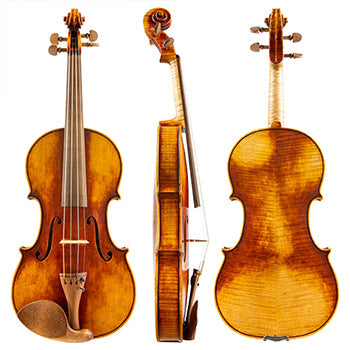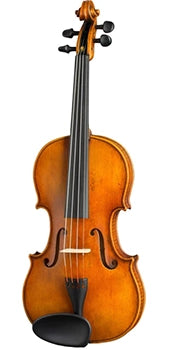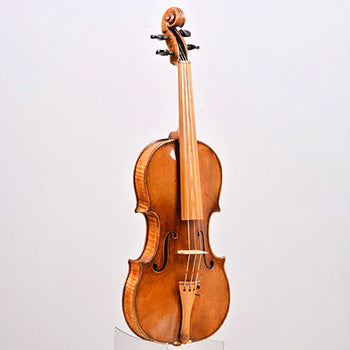BOOK AN APPOINTMENT
Book an Appointment


Tropical hardwoods such as ebony and rosewood are some of the most highly regarded timbers to be used as fittings for orchestral string instruments. This is because of their density, hardness and naturally dark colour. However, the excessive and unmonitored exploitation of these materials has caused a rapid depletion of availability. Governmental organisations such as ‘The Convention on International Trade in Endangered Species’ (CITES) aims to protect, impose restrictions and closely monitor the trade, import and export of these woods. With the trade of ebony and rosewood becoming more restricted and the need for official documentation increasing, more and more luthiers and musicians are turning to alternative materials. A number of sustainable alternatives have been developed to offer violin-makers the same physical properties as tropical hardwoods at a reduced environmental cost.
Ebony trees grow in tropical forests and grasslands around the world. It is an extremely dense wood that has a very fine and smooth texture. Ebony has been the main material used for the fingerboard on orchestral stringed instruments for centuries. Rosewood has mainly been used for fittings such as the tailpiece, pegs and end button. Rosewood is used on account of its rich, multicoloured grain and resonant sound.
Ebony is a very slow growing tree and can take anywhere from 100 to 200 years to fully develop. From the ebony trees that are then selected to be cut down, only 1 in 10 are of a suitable quality and colour to be used (and it is only known if they will be suitable after they have been cut down). The trees that are not of suitable quality for use are then left on the forest ground to rot.
Due to the high value and demand of woods such as ebony and rosewood they are often the target of overharvesting and trafficking. The illegal logging of ebony and rosewood has severely affected the world’s supply and has become increasingly hard to source. As these tropical hardwoods grow so slowly, their stock has been depleted faster than forests have been able to recover. In fact, rosewood makes up 35 percent of the global wildlife smuggling which is nearly double that of ivory. Much of the illegally cut wood is destined for Asia where furniture made from ebony, rosewood and ivory is highly sought after.
The CITES appendix is a comprehensive list of the specific species in which the international trade must be controlled. On this particular appendix are around 200 species of rosewood and ebony. It is not only the eventual extinction of these trees that is cause for concern, but many of them have an important role in the ecosystems where they originate, providing home and nutrition to a variety of wildlife. In 2017 the sale of rosewood was heavily restricted and it is expected that ebony will soon follow suit. At the moment, CITES has only restricted the trade of ebony sourced from Madagascar.
This is not the first-time instrument makers have had to adapt from the materials that they were previously using due to environmental trade restrictions. Hundreds of years ago ivory began being used by musical instrument makers when the question of ethics was non-existent. Around 1800 when the modern bow was developed, an ivory faceplate about the size of a pinky fingernail was added to the tip. The reasoning for this was that if the bow was dropped on its tip, the ivory itself would take the majority of the force and break rather than the bow itself. This is why so many bows from the 1800s onwards have survived which otherwise would have broken. Ivory was also used as a decorative element to add value and aesthetic beauty to the bow, as well as on the nut and endpin of some older instruments. Most modern bows are not fitted with ivory, but instead with materials such as plastic, silver and gold.
Today if a musician wants to travel overseas and their instrument or bow contains ivory, they need to obtain a CITES musical instrument certificate for the item. To obtain this document the musician must prove that the specific African elephant who supplied the ivory was ‘removed from the wild’ before February 26, 1976, as this is the date that African elephants were listed on the CITES appendix.
As a result of these restrictions, a number of alternative materials have been sourced and developed in place of ebony and rosewood. One such company pioneering sustainable and environmentally, friendly alternatives is Swiss Wood Solutions (SWS). They began by experimenting with other more sustainable tropical hardwoods. However, on account of their density, hardness and sound they were deemed not suitable. Eventually the team at SWS developed a way to ‘densify’ maple and spruce to the same level as ebony and rosewood without having it deform back to its original density when in contact with humidity, moisture and perspiration. To do this, they initially infused untreated maple and spruce with water and then dried them out to commence the ‘hygrothermic densification.’ This essentially subjects the wood to moisture, heat and pressure. The wood is very slowly condensed so as not to break any cell walls. This method also keeps the flexibility and integrity of the original wood intact.
The resulting product developed by the team at SWS is called ‘Sonowood.’ Sonowood has the same physical properties as tropical hardwoods but is entirely legal and environmentally friendly. It is not a composite material but entirely wood with an authentic sound, easy workability and low damping. Despite being a natural material, it is continuously available in constant quality. It protects biodiversity as it is made from sustainable European wood species, none of which are listed on the CITES appendix.

Sonowood Maple is available to be used for the fingerboard, tailpiece, pegs and chinrest. It is made from Sycamore Maple and has a ‘mocha’ colour. Sonowood Spruce is available to be used for the fingerboard and tailpiece. It is made from spruce and is caramel in colour. Sonowood Walnut is available for the fingerboard. It is made from walnut and is dark brown to black in colour. All the wood is sustainably sourced from Swiss forestry mainly in Zurich and Brisons.
There are a number of other companies and luthiers who are also researching viable, legal, sustainable and environmentally friendly alternatives to ebony and rosewood. German luthier Daniel Hillier founded the company ‘Berdani’ and has made a rosewood substitute from densified boxwood and an ebony substitute from compressed paper. The process that Berdani employs has allowed them to adjust the colour of their ebony substitute to black. They have prioritized creating a viable alternative that not only feels and works like ebony but will also involve not too much convincing for traditional luthiers to begin using (as something that is a light brown colour seems to).
Another Swiss company creating more sustainable alternatives is ‘Neo-Ebène’ who are making fingerboards from Corene, a composite material made from resin and sustainable wood. Corene is more durable than ebony and has been designed not to react with the natural acid found in perspiration that often wears down ebony, does not move with humidity or severe temperature changes and is more resilient to wear from the movement of strings.
Some companies have begun to make the switch by utilizing sustainable fittings in their products. Gewa from Germany has begun using flaxwood for the fingerboard and nut on their student instruments. Roderich Paesold, also from Germany has a violin they’ve named ‘Green World’ and it features a chin-rest, tailpiece and geared pegs made of a composite material developed by Wittner. The button is made from boxwood, the nut from vulcanized fibre and it has a Corene fingerboard.

Some luthiers are also beginning to experiment with native and indigenous woods as possible alternatives. British violinmaker Roger Hansell is experimenting with a selection of native and sustainable British hedgerow woods including hawthorn, blackthorn, olive wood and pear wood. Eric Meyer from Portland and Ted White from Victoria in British Columbia have been experimenting with mountain mahogany as it is one of the hardest native North American woods. White is also experimenting with a composite tailpiece that contains a resin from cashew nutshell liquid and recycled paper for reinforcement.
Blackwood is another sustainably made product that has appeared on the market as an ebony alternative. It is made from pinewood grown in New Zealand and then processed using organic chemicals. Carbon Fibre fittings are also being made by Sound Composites in Eugene. Sound Composites fingerboards have a carbon-fibre core with a thin layer of graphite-based tooling material over the arc and on the sides as this allows the board to be dressed when necessary. Under the main carbon-fibre construction is a maple veneer which gives an appropriate surface for gluing.
In the past, the price of ebony has always been reasonably affordable and sustainable options were more expensive. As ebony becomes scarcer and harder to source, the demand has gone up and so has the price. Both Berdani and SWS have made their prices more competitive with ebony as their product has become more popular and so expanded their manufacturing capability.
One of the reasons SWS has found luthiers hesitant to accept their product has been the colour which is more of a brown than traditional black like ebony. However, the fact that it is not a traditional colour may speed things along at the airport as it will be obvious that this is not a traditional hardwood such as ebony. SWS recently fit a Sonowood Spruce fingerboard to a Stradivarius violin. Once the general public have seen a non-traditional material on such a well-known and sought-after instrument it may increase acceptance and help ease the transition for luthiers to accept more non-traditional alternatives.

Stradivarius from 1721 with a fingerboard and tailpiece from Sonowood spruce.
Photo courtesy of Swiss Wood Solutions
One of the biggest reasons that musicians and luthiers are hesitant to make the switch from ebony and rosewood is possibly psychological. They don’t want to use something that hasn’t necessarily been accepted and isn’t seen on all the famous instruments that the professionals use. When it becomes necessary to move from ebony on account of higher restrictions something that looks, feels, sounds and works like ebony seems like it will most readily be accepted, especially by traditional luthiers. As we adapted with the restriction of ivory, we will also adapt with the restriction of ebony and rosewood.
This could actually be an opportunity to not only move to more sustainable options for the environment (not just because of laws and restrictions) but it could actually result in a more positive tonal change, sound and innovation bringing us into the 21st century and teaching us more about how instruments work.
Would you like to know more about non-traditional materials and fitting them to your instrument? We stock various non-traditional fittings such as Wittner and Sonowood. Get in touch today to learn more!
Laura Case is a fine instruments specialist. Laura studied Music and Education (Honours) at The University of New South Wales, completing a thesis entitled Innovations and the Stradivari Conundrum; Psychological, Sociological and Emotional but not Musical.